Intel D975XBX: Intel brings their Bad-Axe to Market
by Gary Key on January 26, 2006 12:05 AM EST- Posted in
- Motherboards
INTEL D975XBX: Features
The Intel SATA ports are conveniently located below the ICH7R chipset and to the left of the primary IDE connector. The SATA ports feature the new clamp and latch design. Unlike other 975x boards, the SATA ports are not color-coded for primary and secondary operation. We found the positioning of the SATA ports to be excellent when utilizing the ATI CrossFire cards in the primary and secondary PCI Express connectors.
The Silicon Image SiI 3114 SATA RAID port connectors are clustered on the left edge of the board. The Intel USB connectors and chassis panel are located below the SiI 3114 port connectors and to the left of the Intel SATA port connectors. The BIOS configuration jumper block is a traditional jumper design located above the IDE port connector. The location of this jumper was acceptable during repeated usage.
The first physical x16 connector located next to the MCH heat sink is the primary PCI Express connector and is set up for electrical routing in x16 or x8 operation. The x16 interface supports full duplex transfers up to 8 GBytes/second in x16 operation and single-ended transfers are supported up to 4 GBytes/second in x8 operation.
The next physical x16 connector is the secondary PCI Express connector and is set up for electrical routing in x8 operation. This connector also fully supports x4 and x1 PCI Express add-in cards. The final physical x16 connector is set up for electrical routing in x4 operation and fully supports x4 or x1 PCI Express add-in cards.
We did not have any issues installing an ATI X850 Crossfire Edition setup in the primary and secondary x16 PCI Express slots. This configuration will physically render the first PCI slot useless. There were no issues utilizing this slot with video cards containing single slot cooling systems.
The MCH and ICH chipsets are passively cooled with heat sinks that do not interfere with any installed peripherals. In fact, this system kept the chipsets cool enough that additional chipset voltage was not a factor in our overclocking tests. Intel places the eight-pin 12V auxiliary power connector at the top of the CPU socket area, but out of the way of most aftermarket cooling solutions. However, the 4-pin auxiliary power connector is located in a difficult position and can hamper airflow with cabling that crosses over the heat sink.

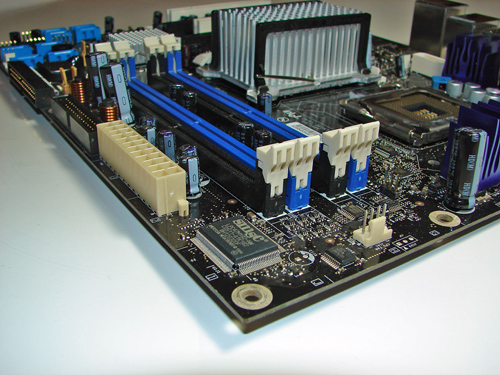
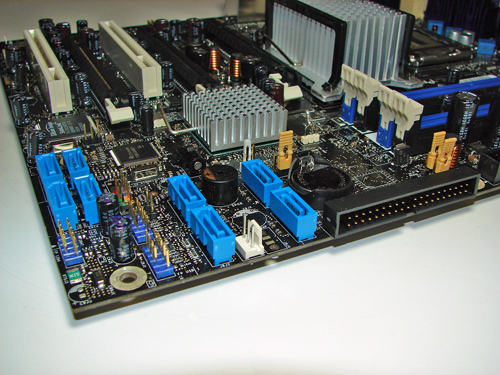
The Intel SATA ports are conveniently located below the ICH7R chipset and to the left of the primary IDE connector. The SATA ports feature the new clamp and latch design. Unlike other 975x boards, the SATA ports are not color-coded for primary and secondary operation. We found the positioning of the SATA ports to be excellent when utilizing the ATI CrossFire cards in the primary and secondary PCI Express connectors.
The Silicon Image SiI 3114 SATA RAID port connectors are clustered on the left edge of the board. The Intel USB connectors and chassis panel are located below the SiI 3114 port connectors and to the left of the Intel SATA port connectors. The BIOS configuration jumper block is a traditional jumper design located above the IDE port connector. The location of this jumper was acceptable during repeated usage.
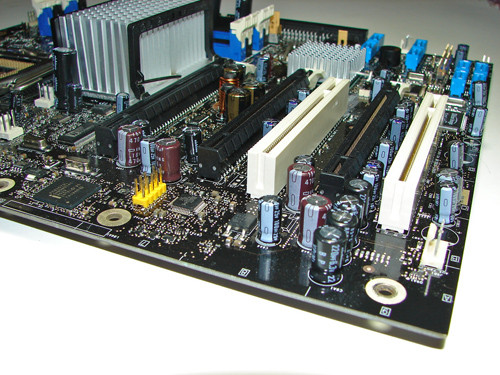
The first physical x16 connector located next to the MCH heat sink is the primary PCI Express connector and is set up for electrical routing in x16 or x8 operation. The x16 interface supports full duplex transfers up to 8 GBytes/second in x16 operation and single-ended transfers are supported up to 4 GBytes/second in x8 operation.
The next physical x16 connector is the secondary PCI Express connector and is set up for electrical routing in x8 operation. This connector also fully supports x4 and x1 PCI Express add-in cards. The final physical x16 connector is set up for electrical routing in x4 operation and fully supports x4 or x1 PCI Express add-in cards.
We did not have any issues installing an ATI X850 Crossfire Edition setup in the primary and secondary x16 PCI Express slots. This configuration will physically render the first PCI slot useless. There were no issues utilizing this slot with video cards containing single slot cooling systems.
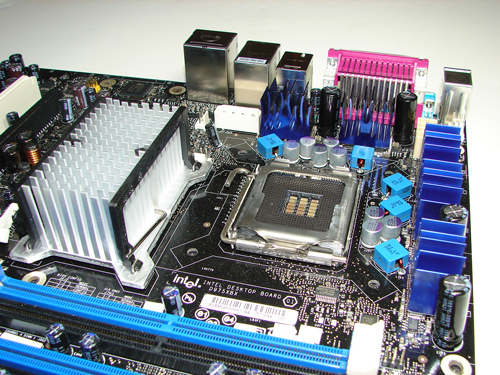
The MCH and ICH chipsets are passively cooled with heat sinks that do not interfere with any installed peripherals. In fact, this system kept the chipsets cool enough that additional chipset voltage was not a factor in our overclocking tests. Intel places the eight-pin 12V auxiliary power connector at the top of the CPU socket area, but out of the way of most aftermarket cooling solutions. However, the 4-pin auxiliary power connector is located in a difficult position and can hamper airflow with cabling that crosses over the heat sink.
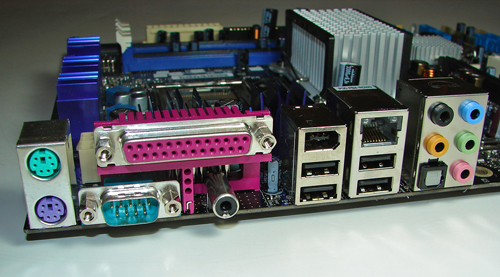










34 Comments
View All Comments
ruprecht - Thursday, January 26, 2006 - link
What the hell is wrong with Americans? Just say bad ass, it's hardly a hard-core expletive!yacoub - Friday, January 27, 2006 - link
Professional image versus immaturity. Anandtech has a professional image and likely wants to maintain it.Griswold - Friday, January 27, 2006 - link
...land of the free. Whatever.DigitalFreak - Thursday, January 26, 2006 - link
We're prudes! Well, not me, but...Avalon - Thursday, January 26, 2006 - link
This board is pretty pitiful, IMO, when several other solutions out there can outpace it. Unless the board is offered cheaper than the competition, I see no reason to buy it.JarredWalton - Thursday, January 26, 2006 - link
Intel's proven reliability and support. Some people will happily give up 10% or more performance just for a major name like Intel. I'm not one of them, but they do exist.... :)yacoub - Friday, January 27, 2006 - link
But you pay a lot more for it...Zebo - Friday, January 27, 2006 - link
No knowledgeable computer hardware expert seriously believes that there is enough of a stability difference between the platforms to warrant a scientific comparison or research study by an objective outsider. Most "issues" stem from OE or bloated buggy SW and drivers, simple as that - not the hardware itself.Toms tries such a comparison but as you know a sample size of one is'nt very scientific so we'll discount intels 11 reboots two Asus boards, two intel boards, one gigabit board to AMD's 0 reboots in the stress test.:D:)
Zebo - Friday, January 27, 2006 - link
Or should I say where's the proof over anything else? Sounds like urban legend to me. Something the intel boys claim with almost programed resposivness then stop replying in that thread once asked for proof.Sunbird - Thursday, January 26, 2006 - link
Excuse my ignorance, is Bad Axe a new american slang word?